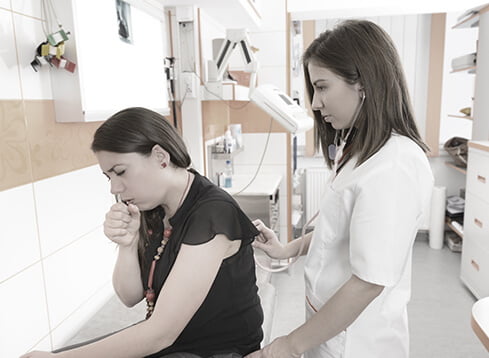— Matrika Heritage Hospital
Tuberculosis
What Is Female Genital Tuberculosis (FGTB)?
Genital TB (Tuberculosis of the Female Genital Tract) is mostly secondary to pulmonary TB or extrapulmonary foci such as kidneys, brain, skeletal system and gastrointestinal system. TB bacilli infect the genital tract by four routes – blood transmission (with lungs as the common primary focus), descending direct spread, lymphatic spread and rarely as primary infection of the genitalia through sexual transmission. The genital organs affected by Mycobacterium tuberculosis (in descending order of frequency) are as follows: fallopian tubes (95-100%), uterine endometrium (50-60%), ovaries (20-30%), cervix (5-15%), uterine myometrium (2.5%) and vagina/vulva (1%).

What are the symptoms of Genital Tubeculosis?
- Mostly asymptomatic
- Irregular periods in terms of flow, frequency and duration
- Abnormal vaginal discharge
- Infertility
- Pelvic pain
When to visit a gynaecologist for FGTB?
- Please see your gynaecologist if you are bothered with abnormal periods, pelvic pain, infertility, unexplained weight loss with low grade fever. We at Matrika Heritage Hospital offers detailed examination and the best treatment for genital tuberculosis in Darbhanga.
Why do you have all these symptoms in pelvic with genital tuberculosis?
Genital tuberculosis changes the normal tubo-ovarian anatomy which is the main cause of infertility. Tubercular endometritis causes ulceration, necrosis and haemorrhage which can destroy the endometrium and thus hinder implantation of a healthy embryo. Adhesions may occur between ovaries and adjacent pelvic organs resulting in adnexal mass, causing pelvic pain. Intrauterine adhesions if occur can result in partial obliteration of the uterine cavity, causing the symptoms of menstrual abnormalities.

Complications of genital tuberculosis:
- Infertility ( endometrial damage)
- Pelvic pain
- Menstrual irregularities (disturbed ovarian function)
- Tubo-ovarian masses
- Frozen pelvis
- Vaginal discharge
Diagnosis & Treatment
- Demonstration of mycobacterium tuberculosis is not possible in all the cases, a high index of suspicion is required. The diagnostic dilemma arises due to varied clinical presentation, diverse results on imaging and endoscopy and availability of series of bacteriological, serological and histopathological tests which are often required to get to evidence of genital TB . The diagnostic approach used is family history of TB or history of antituberculous therapy (ATT) in a close family member or a past history of tuberculosis or anti-tubercular treatment in the patient may show recrudescence of tuberculosis in the genital region. We at Matrika Heritage Hospital provide best genital tuberculosis treatment, vaginal discharge treatment in Darbhanga after a detailed analysis. Our female genital tuberculosis treatment is cost effective and economical despite the long course of treating this infectious disease caused by bacteria. Ignoring the symptoms and delaying the treatment may cause more complications and the cost may further increase. We always do proper screening for tuberculosis in all our infertility patients.
Treatment of Female Genital Tuberculosis:
- Medical treatment of FGTB includes multidrug regimes categorized under DOTS (Directly Observed Treatment Short-Course) Strategy Treatment.
- Treatment of Chronic Cases, Drug Resistant and Multidrug Resistant (MDR).
- Surgical treatment- There are much higher chances of complications during surgery in women with genital TB in hysteroscopy, laparoscopy, vaginal hysterectomy and laparotomy.
- IVF (IN VITRO FERTILIZATION) in case of infertility.